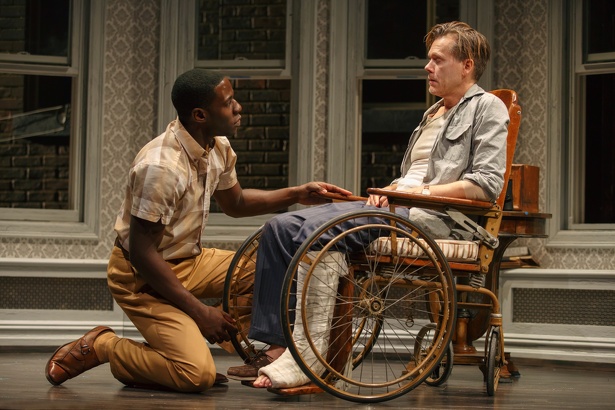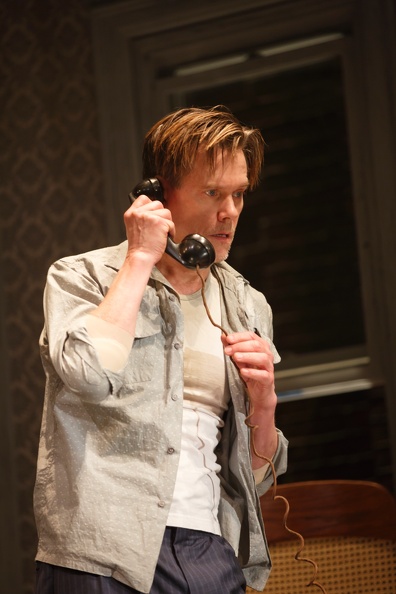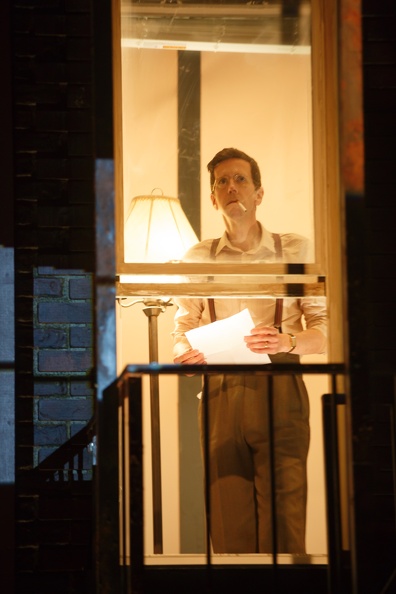The first time I saw Rear Window, Alfred Hitchcock’s 1954 thriller about a wheelchair-bound photographer who solves a murder while gazing out his window, I was so scared by the gripping climax that I couldn’t shut my eyes in bed for fear of intruders in the dark. Mind you, I was 12 years old. Watching it on video years later, I could only smile as a pre-Perry Mason Raymond Burr, coming at night to kill Jimmy Stewart, was thwarted by, um, the glare of the hero’s flashbulbs.
In the adaptation of the story that premiered last month at Hartford Stage, the lead is a tough investigative reporter and the climax is a more credible if equally shadowy conflict. Indeed, the play is quite different from the film, though they both take off from the same source, a short story by Cornell Woolrich called “It Had to Be Murder.”
Woolrich is a largely forgotten writer of 1940s pulp fiction who was a key creator of the noir genre of dark, cynical post-war thrillers. He was also an alcoholic and closeted homosexual whose one brief marriage ended disastrously. Those real-life elements are woven into Keith Reddin’s stage adaptation, along with interpolations not found in either the short story or the movie. The noir atmosphere is heightened by a sound design that features late-night saxophones and spine-tingling orchestral stings.
Hal Jeffreys, called Jeff, confined at home by a shattered leg in a sweltering New York August, passes the time drinking and peering out the window into the lives of his neighbors in the tenement across the back courtyard. When the sultry, disdainful wife of a milquetoast husband in one of those apartments suddenly disappears, he becomes obsessed with the idea that she’s been murdered.
The production is a vehicle, presumably Broadway-bound, for Kevin Bacon. But the real star of the show is the set by Alexander Dodge.
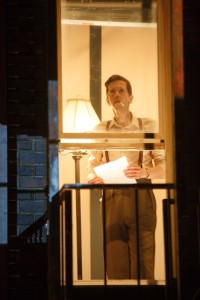 At first, we only glimpse the apartments next door through the windows of Jeff’s own flat. Then suddenly the back wall drops away, revealing a multi-story brick façade through whose windows we glimpse the comings and goings of the tenants, including a newlywed couple, a single mother, a prostitute who parades her body in the open window, and a writer clacking away on a manual typewriter (a nod to Woolrich?). That wall of windows is impressive enough, but then one of the apartments, fire escape and all, swivels around to expose its interior rooms, where Jeff’s suspect does suspicious things.
At first, we only glimpse the apartments next door through the windows of Jeff’s own flat. Then suddenly the back wall drops away, revealing a multi-story brick façade through whose windows we glimpse the comings and goings of the tenants, including a newlywed couple, a single mother, a prostitute who parades her body in the open window, and a writer clacking away on a manual typewriter (a nod to Woolrich?). That wall of windows is impressive enough, but then one of the apartments, fire escape and all, swivels around to expose its interior rooms, where Jeff’s suspect does suspicious things.
Reddin’s script inflates the original bare-bones narrative by expanding one character and introducing a new plot thread. Jeff, we learn, has had his leg broken after exposing official corruption and Sam, merely the black “houseman” in the short story, becomes an ambitious young writer who insinuates himself into Jeff’s employ because he admired the reporter’s scathing columns on an instance of racial injustice in the South (This theme is based on the 1943 case of a 14-year-old black boy convicted and executed on false evidence for the murder of two white girls.) The backstory lends grit if not cohesion to the narrative, as does Jeff’s compulsive drinking, fed by his confinement, anger at the corrupt system and remorse over his short-lived marriage – a sharp departure from Hitchcock’s Technicolor version.
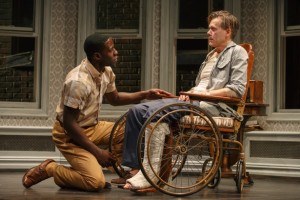 Bacon, subduing his boyish charm, is unnervingly effective as the truculent, disillusioned newspaperman surviving on whiskey and wisecracks. McKinley Belcher III is a persuasive Sam, growing slowly from starstruck acolyte to tough-love partner. John Bedford Lloyd is Boyne, a hard-edged (and racist) city cop in the Robert Mitchum mold, and Robert Stanton a quiet, bespectacled killer. Melinda Page Hamilton doubles as the blowsy victim and (symbolically) the beautiful wife in Jeff’s tortured memories.
Bacon, subduing his boyish charm, is unnervingly effective as the truculent, disillusioned newspaperman surviving on whiskey and wisecracks. McKinley Belcher III is a persuasive Sam, growing slowly from starstruck acolyte to tough-love partner. John Bedford Lloyd is Boyne, a hard-edged (and racist) city cop in the Robert Mitchum mold, and Robert Stanton a quiet, bespectacled killer. Melinda Page Hamilton doubles as the blowsy victim and (symbolically) the beautiful wife in Jeff’s tortured memories.
There are some thrills in the later going, and there’s a satisfyingly ambiguous coda to the final action, but the plot often proceeds more like a plodding procedural than a spellbinding thriller. What I really missed is what happens – or rather, doesn’t happen – in the relationship Jeff zeroes in on. We see a mousy husband belittled by a restless wife, but nothing like a crisis or breaking point that would lead him to murder or his rear-window neighbor to suspicion. Maybe this is intended to make us wonder, as Sam and Boyne do, if Jeff is going stir crazy or suffering delirium tremens. But the lack of at least an equivocal incident or sequence merely weakens the premise.
For me, however, the biggest hole in Reddin’s script and Darko Tresnjak’s production is the failure to bring Jeff’s neighbors to life. The play introduces the tangential apartment-dwellers perfunctorily and then uses them as between-scene extras, while Jeff’s attention goes almost immediately, and exclusively, to the unhappy couple on the fire escape. What a lost opportunity – not only to flesh out the “backdrop” and create a mosaic of city life before slowly homing in on the key apartment, but also to make the supporting cast something more than animated set dressing.
The show closed last weekend, but I wouldn’t be surprised to find it in next season’s Broadway lineup, thanks to its bankable star. I hope New Yorkers will find a more fully realized play, to equal its awesome set.
Photos by Joan Marcus
If you’d like to be notified of future posts, email StageStruck@crocker.com


